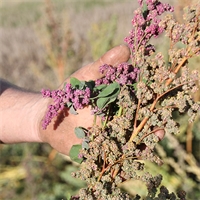10Apr
The importance of starch
Article & images supplied by Ruminate
One of the New Zealand dairy industry’s strengths is its ability to grow relatively cheap grass, which makes up the bulk of our cows diet. However, if we breakdown the components of what is in our grass, this is not a complete nor balanced diet and is often missing minerals, traces, vitamins, as well as starch.
Why is starch important? A cow’s rumen has billions of microbes that break down pasture in utilisable parts that the cow can then use, these are called volatile fatty acids (VFAs). Therefore, when a cow has more microbes it can utilise feed more effectively, resulting in a higher level of energy. The main driver to make more microbes is carbohydrate. Pasture is around 5% soluble sugars and is less than 0.5% starch, making pasture extremely low in this essential dietary component.
Pasture can also be high in crude protein, this mainly occurs during the spring and early summer months and then again in autumn, although high urea use and irrigation mean we are often over-feeding protein.
Crude protein from pasture is a rumen degradable nitrogen source (a building block for microbes making VFAs). Too much protein in the rumen, means the microbes can’t keep up, which produces ammonium in the rumen, this is absorbed through the rumen wall into the blood and removed from the animal via the kidneys. As a result, a large amount of nitrogen (now in the form of urea) in the urine of cattle primarily fed pasture is created. This is an expensive energy process for the cow, using critical energy that is required to make milk, and get/maintain a pregnancy.
The milk quality results can indicate how much rumen degradable nitrogen is in the diet. High rumen degradable nitrogen is indicated with a milk urea and nitrogen (MUN) that is greater than 30. The sweet spot for MUN is between 20 and 30, this is dependent on the total diet composition. A low MUN (less than 20) may indicate that there is not enough dietary protein. Furthermore, the addition of starch into the diet can be used in manipulate milk quality. Increases in the amount protein in the milk can be achieved with the addition of starch.
Balancing the diet with starch has the ability to have environmental benefits. By utilising dietary protein with rumen microbes, there will be less dietary protein which is unutilised and ends up wasted in the form of urine and faeces. We often see ‘piss patches’, which are a result of there being a large amount of urea in the urine. In some pastures where cows simply don’t have enough energy to deal with the available protein, the pasture has actually been burnt out. This is a visual example of the result of there not being enough energy in the diet for microbes to deal with the high crude protein in our ryegrass pastures. One aspect of mitigating the detrimental effect of nitrogen on the enivironment would be trying to balance the carbohydrate and protein supply in the rumen.
In order to utilise the crude protein in pasture and provide plenty of energy for rumen microbes, supplying a source of starch in the diet is essential. Starchy feeds includes the likes of barley, wheat and maize. An interesting comparison of feed can be made, where instead of making buying decisions purely on a dry matter (DM) basis, but also on how much starch the feed has.
|
Feed Source
|
Barley
|
Wheat
|
Kibbled Maize
|
Tapioca
|
PKE
|
|
Starch %
|
58 %
|
69 %
|
72 %
|
63 %
|
2 %
|
|
Dry Matter %
|
88 %
|
88 %
|
89 %
|
88 %
|
92 %
|
|
Price per tonne
|
$ 400 / t
|
$ 370 / t
|
$ 420 / t
|
$ 330 / t
|
$ 300 / t
|
|
Price per kg starch
|
23 c / kg
|
26 c / kg
|
30 c / kg
|
21 c / kg
|
$6 / kg
|
|
Price per kg DM
|
35 c / kg
|
33 c / kg
|
37 c / kg
|
29 c / kg
|
33 c / kg
|
The benefits of incorporating a source of starch into the diet include better body condition scores throughout the season, better holding of milk production at the peak of the season and better reproductive results to name a few.
The trick to feeding starch is to feed it safely. Whilst starch is great for rumen microbes it is in fact so good that they produce significant volumes of VFAs. This is great if the cow can absorb them, although it is often accompanied by a drop in rumen pH, reducing rumen function and resulting in acidosis.
Talk to your Ruralco Representative to discuss how you can safely include starch into your cows diet and enjoy the benefits without the risk.
Related

A Christchurch family fishing company has placed one foot in the sea and another on the land with th...
Read More

Weed competition can have a significant detrimental effect on brassica yield from very early in the ...
Read More

Once seen as the “protein farm” for the United Kingdom with an ample supply of butter, cheese and ...
Read More

Introducing Agricom’s smartest grass yet. Align AR37. Our new, extremely late heading, tetraploid p...
Read More

For many years New Zealand’s horticultural sector has played second fiddle to the country’s major ...
Read More

We look at the latest Agronomy update for spring pastures, cereals and winter feed.
Read More